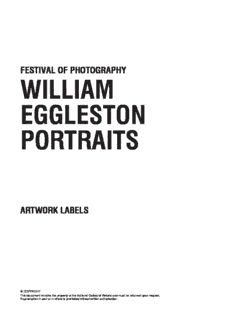
artwork labels festival of photography PDF
Preview artwork labels festival of photography
FESTIVAL OF PHOTOGRAPHY WILLIAM EGGLESTON PORTRAITS ARTWORK LABELS © COPYRIGHT This document remains the property of the National Gallery of Victoria and must be returned upon request. Reproduction in part or in whole is prohibited without written authorisation. William Eggleston Portraits Few photographers of the last century have had such a profound influence on contemporary photographic portraits as the American photographer William Eggleston, who was born in Memphis, Tennessee, in 1939. Although Eggleston is not usually regarded as a portraitist, pictures of people have long been central to his practice. Photographed near his home in Memphis, and in the Mississippi Delta where he grew up, many of Eggleston’s images depict friends and family. Still more are of strangers – taken unawares, and performing everyday tasks such as dining, shopping or waiting for a bus. These spontaneous and unconventional pictures pose deep questions about humanity, self, memory and experience. Eggleston’s ‘portraits’ are neither straightforwardly documentary nor sentimental. The artist instead asks that we view them ‘democratically’, pushing beyond the mere appearance of things to find something more valuable and more elusive. This exhibition brings together 100 photographs, beginning with works made in 1960s when Eggleston first embraced colour. Many images are from the artist’s personal archive and are exhibited here for the first time. William Eggleston Portraits is organised by the National Portrait Gallery, London, with support from the artist and the Eggleston Artistic Trust and presented by the National Gallery of Victoria. Initially, Eggleston photographed in colour using readily available films which he sent to drugstore labs for processing and printing. In his search for what he called the ‘ultimate quality’ colour print, in the early 1970s Eggleston happened upon the dye transfer process, a close cousin of Technicolor in cinema film. Marketed by Kodak since the 1930s, dye transfer had until that point been used mainly for high-end commercial work. Eggleston began to use it for artistic purposes and his 1976 exhibition Photographs by William Eggleston, at New York’s Museum of Modern Art, is a landmark in the history of colour photography. Dye transfer printing requires tremendous dexterity and skill. The printer separates the original image into three negatives – red, yellow and blue. These are printed separately onto transfer films dyed cyan, magenta and yellow, which are printed one on top of the other in perfect registration to build up the final, full-colour image. Following Kodak’s decision to withdraw matrix film in 1991, in recent years Eggleston has taken advantage of digital printing techniques, which afford him greater control over colours and enable him to print in sizes that would have been unimaginable using earlier methods. Untitled (Peter Lindamood) 1960s gelatin silver photograph Eggleston Artistic Trust Peter Lindamood was a bon vivant and art critic who wrote for publications including Harper’s Bazaar and the avant-garde magazine View. View is credited with helping introduce the American audience to Dada and Surrealism. In March 1945 Lindamood edited an issue dedicated to his friend, the Dada artist Marcel Duchamp. ‘Eccentric and delightful’, according to a friend, Lindamood rented an apartment nearby to the Egglestons’, above a carriage house that Eggleston used as a darkroom. Lindamood was part of a prominent circle of influential Southern writers that included Truman Capote and Tennessee Williams. Untitled (Lucille Fleming, Sumner, Missouri) c. 1965 gelatin silver photograph The J. Paul Getty Museum, Los Angeles 2000.41.14 Eggleston grew up partially in the care of Lucille Fleming, who worked as a housekeeper for the families of his grandfather and uncle, in Sumner, Mississippi. Essentially a member of the family herself, Fleming spent more than fifty years in their employ. Fleming was also a talented quilt-maker, and examples of her work are held in several public collections, including the Center for the Study of Southern Culture in Oxford, Mississippi. Eggleston’s father joined the Navy shortly after his son’s birth, and was posted to a base in Florida. His mother followed him there, leaving the young William with his grandparents. Untitled 1960s gelatin silver photograph Eggleston Artistic Trust Untitled 1973–74 gelatin silver photograph Eggleston Artistic Trust Untitled 1973–74, printed 2005 gelatin silver photograph Eggleston Artistic Trust Untitled (Marcia Hare, Memphis, Tennessee) c. 1975 dye transfer print Eggleston Artistic Trust In addition to its extraordinary colouration, this portrait is remarkable for its clever use of focus. Only the woman’s camera, arm and head are rendered sharply, giving these elements of the picture extra dramatic weight. The grass on which she lies is largely out of focus, forming an ethereal, cloud-like bed, while her dress is sharp at the neckline, becoming increasingly fuzzy in the lower right. Her chest is adorned with a string of translucent red buttons, sumptuous and gleaming like jellybeans. Untitled (Alex Chilton) c. 1973, printed 2016 pigment print Eggleston Artistic Trust Eggleston shows celebrated musician Alex Chilton in a state of euphoria. Photographed on the front steps of Eggleston’s house, he is illuminated from below by floodlights. A key member of the Memphis alternative music scene in the 1970s, Chilton co-founded the cult band Big Star. Eggleston and Chilton were neighbours and occasional collaborators: Eggleston supplied pictures for various Big Star albums, and even performed piano on the album Third/Sister Lovers (1978). Chilton’s mother Maru ran an art gallery specialising in regional crafts, and she and her husband hosted soirees at their house, which attracted artists and musicians.
Description: